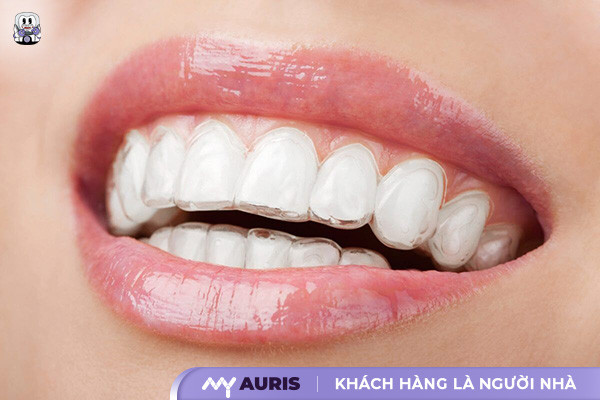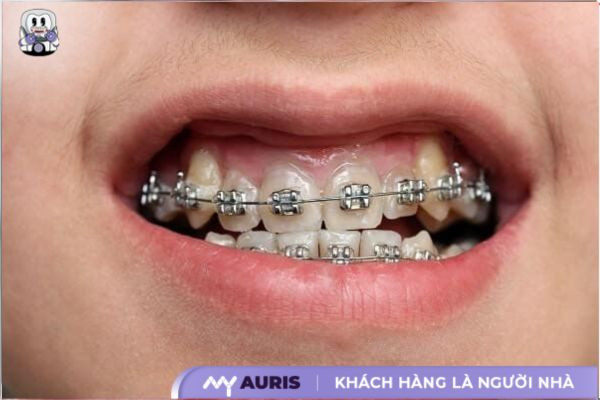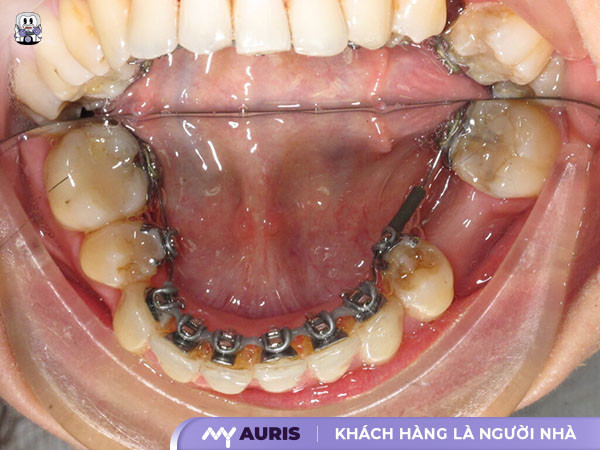Most people seek orthodontic treatment with the desire to improve the beauty of their smile and make their teeth straighter and more attractive. However, beyond aesthetic factors, this orthodontic method also brings many practical benefits to oral health. So, what are the effects of braces and why are more and more people choosing them? The information below will help you better understand the positive values that braces bring – not just for appearance but also for long-term health.
Benefits of Braces: Radiant Smile, Comprehensive Health
Braces are not only an aesthetic orthodontic solution but also bring many long-term benefits for oral health. Besides the advantage that braces do not require surgical intervention and preserve natural teeth to the maximum, this method also helps comprehensively improve everything from chewing function to pronunciation.
Enhanced Aesthetics, More Harmonious Face
Thanks to the tightening force from the brace system, teeth are gradually moved to their ideal position, ensuring balance with the jawbone structure. After removing braces, users will have beautiful, straight teeth, a proper bite, and a more balanced, slender, and harmonious face. This is a clear benefit of braces that many people highly appreciate.

Effectively Improve Chewing Function
A properly aligned set of teeth is not only aesthetically pleasing but also significantly improves chewing ability. In cases of overbite, underbite, or misaligned bite, orthodontic treatment will move the teeth into the correct position, thereby optimizing the function of grinding food and aiding digestion.
Preventing Oral Health Problems in Children
In young children, because the jawbone is still soft, early orthodontic treatment helps dentists easily correct misaligned teeth. This not only shortens treatment time but also helps shape the jawbone structure and proper bite in adulthood. At the same time, evenly spaced teeth will reduce food impaction, helping children maintain oral hygiene more easily, preventing cavities and gum inflammation.

Correcting Speech Impediments
One of the lesser-noticed benefits of braces is their ability to correct speech impediments. When teeth are properly aligned and work well with the lips and tongue, users will articulate more clearly and accurately – especially with sounds requiring high precision such as “s”, “x”, “r”.
Common Misconceptions About Braces – Don’t Miss the Chance for a Beautiful Smile!
Braces Cause Prolonged Pain
Many people worry that braces will cause prolonged pain for months. In reality, the feeling of soreness and tightness only occurs during a few stages such as: placing separators, attaching metal brackets, increasing archwire tension, etc. After that, the pain will gradually subside and depend on each individual’s pain threshold. For those with a lower threshold, the discomfort will be more noticeable, but it can be completely managed with guidance from the dentist.
Braces Are Unattractive
Previously, metal braces made users feel self-conscious when communicating. Today, many modern aesthetic orthodontic solutions such as clear aligners or removable appliances have emerged, offering more discretion and comfort. Depending on the dental condition, financial situation, and aesthetic needs, the dentist will advise you on the most optimal method.

Weight Loss, Decreased Health During Braces
It’s true that in the initial days, the soreness when chewing can make you reluctant to eat, leading to slight weight loss. However, if you follow the correct diet, eat soft foods, avoid overly chewy or hard foods, and combine this with the habit of cutting food into small pieces, you can absolutely maintain stable health and prevent brackets from coming loose.
Tooth Extraction Poses Risks to Vision and Nerves
Tooth extraction creates space, which helps teeth move effectively, especially when the jawbone is firm and teeth are misaligned. Some people worry that extracting multiple teeth will affect vision or nerves. In reality, before performing the minor surgery, dentists always require an X-ray to determine if the tooth roots are close to nerves. When performed by a skilled dentist, the risk of complications is very low.
Braces Make Teeth More Prone to Cavities
During the bracing process, plaque and food debris can easily stick to the brackets, making oral hygiene difficult. If not cared for properly, the risk of tooth decay and gum recession will increase due to enamel erosion and the impact of acids from food at adjacent points. To prevent this, maintain good brushing habits, use dental floss, and have regular dental check-ups.
Teeth Weaken After Braces
Many people fear that the impact from aligners and brackets will weaken their teeth. The truth is that if performed with the correct technique, quality materials, and a skilled dentist, the teeth will be healthy and strong. Conversely, if the dentist’s technique is poor or substandard materials are used, the quality of the teeth can be affected. Therefore, choose a reputable dental clinic to ensure effectiveness.
Orthodontic Treatment Takes Too Long
Orthodontic treatment duration depends on the complexity of the teeth, the treatment progress, the patient’s desires, and age. If no extractions are needed, the average time is 18 months; for cases with impacted teeth or requiring extractions, it’s about 24 months. In some special cases, when combined with porcelain restorations, it can be shortened to just a few months to a year.
Too Old for Braces
Another misconception is that only people under 30 can get braces. In reality, you can absolutely get braces at any age, provided you meet the health requirements. With modern techniques and advanced methods, orthodontic treatment for adults has become easier and more effective than ever.
Overview of Popular Braces Methods Today
Braces with Metal Brackets
This is an orthodontic method that uses a metal framework, capable of effectively correcting issues such as buck teeth, misaligned teeth, etc. Although cost-effective, this type of metal bracket often makes oral hygiene difficult and is not highly aesthetic. Nevertheless, thanks to its wide applicability and proven effectiveness, this method is still chosen by a large number of patients.

Braces with Ceramic Brackets
Similar to the metal method, ceramic bracket braces also use elastics and archwires, but the difference lies in the material: the brackets are made from high-quality ceramic, which is translucent white, similar to the color of teeth, enhancing the aesthetic appeal for users. This is an ideal choice for those who need to maintain their appearance throughout their orthodontic journey.

Self-Ligating Braces
Unlike the two techniques above, self-ligating braces do not use elastic ties; instead, they feature an automatic slide mechanism that securely holds the archwire. As a result, brace wearers can reduce their frequency of dental visits and avoid constant adjustment of tightening forces. This is an optimal choice for both time and convenience.

Lingual Braces (also known as Incognito Braces)
This method involves attaching brackets to the inner surface of the teeth, making the appliance almost invisible, thereby enhancing aesthetic effectiveness. However, because this bracing technique is quite complex and requires high precision, you should choose an experienced dentist to ensure safety.
One point to note is that since the brackets are on the inner surface, they can cause discomfort, especially when in contact with the tongue, and oral hygiene will also be more challenging compared to external bracing methods.

Invisalign Clear Aligners
Among modern orthodontic methods, Invisalign clear aligners are highly regarded for their aesthetics and convenience. The aligners are made from safe, health-friendly dental plastic, and are transparent, making them almost invisible when worn – helping you feel more confident in communication.

The aligners can be easily removed and reinserted, making them very suitable for busy individuals. Each patient will have a custom-designed set of aligners based on their specific dental characteristics and treatment stages. Regular check-ups are typically scheduled every 2 weeks to change aligners and monitor the effectiveness of the treatment.





